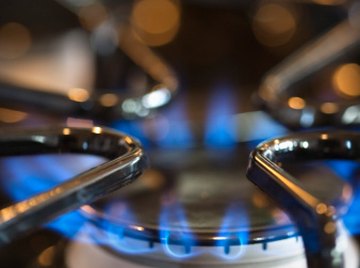
Natural gas is used to heat homes, cook food and power motor vehicles. Gases are measured by how much space, or volume, they occupy. The volume that a particular amount of natural gas occupies can vary, depending on temperature and pressure; squeezed and cooled enough, and the gas turns to liquid, which takes up even less volume. The gas industry has developed yardsticks for measuring this valuable resource.
By the Foot
Natural gas is bought and sold by the cubic foot. The U.S. standard is the amount of gas that will fill an imaginary box one foot on each side, when the temperature of the gas is 60 degrees Fahrenheit and the pressure is what you'd find at sea level -- one atmosphere, or about 14.7 pounds per square inch. Since industry uses natural gas on a grand scale, you'll often see gas measured in units of 1,000 square feet, mcf or Mcf -- "M" is the old Roman symbol for 1,000 -- or a million square feet, mmcf or MMcf, which means 1,000 times 1,000.
Hot Stuff
Gas volume helps measure how much heat you'll get from that gas. That cubic foot of natural gas yields an average of 1,020 British thermal units, or Btu. A Btu is the amount of heat needed to raise the temperature of one pound of water by one degree Fahrenheit at sea level pressure. Industry uses the average figure as its yardstick because natural gas, which is mostly methane, can contain some impurities, such as nitrogen and carbon dioxide. From a homeowner's point of view, the check he writes to the gas company each month represents payment for the heat content of the gas. The utility company bills by "therms." A therm is 100,000 Btu, the amount of heat you'd expect to generate from about 97 cubic feet of gas.
The Big Chill
Liquefied natural gas, or LNG, is cooled to -260 degrees Fahrenheit. At that temperature, the volume that the cubic foot of gas occupies has shrunk to the point where the same cubic foot can now hold 600 times as much gas. Since the gas now takes up so much less space, it's easier to ship. Refrigerated LNG tankers bring in gas from refineries in Trinidad and Tobago, the United Arab Emirates and other overseas producers. The liquid is then warmed up, turning back into a gas that can be fed into the pipeline network; alternatively, the LNG can be kept chilled and then moved around in trucks.
The Big Squeeze
Compressed natural gas, or CNG, is made using another property of gas. Instead of lowering the temperature to reduce volume, as with LNG, the volume of CNG is shrunk by raising the pressure. To store the same volume of gas in that cubic foot of CNG as you'll find in a cubic foot of LNG, the compressed gas must be squeezed under pressure of at least 3,000 pounds per square inch. That's more than 200 times ordinary atmospheric pressure at sea level. This form of gas is used to power motor vehicles.
About the Author
T.C. Edere is a writer for online publications. Previously, he wrote headlines for newspapers such as "The Plain Dealer" of Cleveland, Ohio, "The Record" of Hackensack, N.J., "New York Post" and "New York Daily News."
Photo Credits
Thinkstock/Comstock/Getty Images
